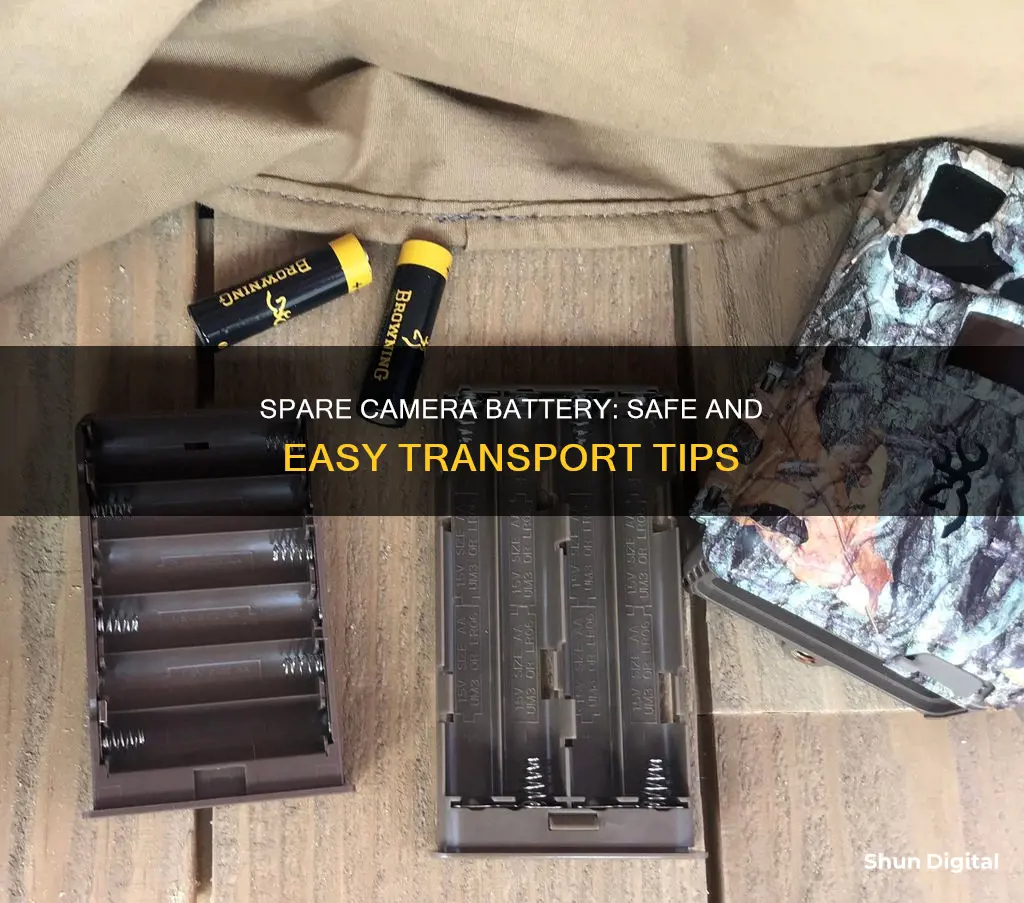
Carrying spare batteries for your camera is essential, especially for outdoor or cold-weather shoots. While some photographers use small pouches, belt hooks, or their pockets, others prefer to keep them in a camera bag. If you're flying, it's important to check the airline's guidelines for carrying spare batteries. Generally, you can bring spare lithium-ion batteries for cameras in your carry-on baggage, but they must be protected from short circuits.
| Characteristics | Values |
|---|---|
| Battery type | Dry cell alkaline, dry cell rechargeable, lithium ion, lithium metal |
| Battery size | AA, AAA, C, D, 9-volt, button-sized, etc. |
| Battery weight | Up to 2 grams of lithium per battery for carry-on |
| Battery packaging | Plastic bag, protective case, tape over contacts |
| Battery quantity | Up to two larger lithium ion batteries in carry-on |
| Battery placement | Carry-on baggage, not checked baggage |
What You'll Learn

Flying with spare batteries
If you're flying with camera equipment, it's important to plan how you'll transport your batteries. Lithium-ion batteries, which are commonly used in cameras, are regarded as dangerous goods due to their potential to short-circuit or catch fire. As a result, there are strict guidelines for carrying them on airplanes.
Lithium-ion Batteries
Lithium-ion batteries are allowed in carry-on baggage, but there are specific rules to follow:
- Quantity and Watt-hour Limits: Each passenger is limited to two spare lithium-ion camera batteries. These batteries must have a rating of 100 watt-hours (Wh) or less per battery. With airline approval, you may carry up to two additional larger lithium-ion batteries with a rating between 101-160 Wh.
- Protection from Damage: It is important to protect lithium-ion batteries from damage, as damaged batteries can pose a safety risk. Keep them in their original packaging or cover the battery terminals with tape to prevent short circuits.
- Carry-on Only: Lithium-ion batteries are prohibited in checked baggage and must be carried in your carry-on luggage. This allows flight crews to monitor the batteries and respond to any potential fire incidents.
- Tape the Contacts: To prevent batteries from touching and causing a short circuit, tape the metal contacts of each battery. You can use camera tape to avoid leaving residue on the batteries.
- Separate Bags: To enhance safety, store each battery in a separate plastic bag.
- Check Airline Policies: Different airlines may have varying policies on carrying camera batteries, so it's important to check with your airline before your trip.
Standard AA and AAA Batteries
Standard AA and AAA batteries have no restrictions and can be freely carried in carry-on or checked luggage. However, it's important to keep them in their original packaging to avoid raising concerns about short circuits.
Other Battery Types
Other battery types, such as car batteries, wet batteries, and spillable batteries, are prohibited from both carry-on and checked baggage unless they are used to power a scooter or wheelchair. If you need to pack a spare battery for these devices, inform the aircraft operator to ensure proper packaging.
Ring's Camera Fees: What's the Real Cost?
You may want to see also

Battery storage tips
General Do's and Don'ts
- Keep batteries in a cool, dry place at room temperature.
- Do not store batteries in a refrigerator or freezer.
- Do not store batteries in hot places, as this can lead to capacity loss, leakage, or rupture.
- Do not store batteries with metal objects such as coins, paper clips, or keys.
- Do not carry loose batteries in your pocket or purse with metal objects.
- Do not disassemble, crush, puncture, or otherwise damage batteries.
- Do not mix old and new batteries, or mix different types or makes of batteries.
- Keep batteries out of reach of children.
- Do not give batteries to young children.
- Do not dispose of batteries in a fire.
- Do not recharge a battery unless it is specifically marked "rechargeable".
- Do not store batteries in a metal box to prevent short circuits.
- Store empty and (semi-)full batteries separately.
- Keep batteries away from grabby children's hands.
- Avoid short circuits between batteries in the box.
- Avoid crushing, puncturing, or putting a high degree of pressure on any battery.
For One-Time-Use Batteries
- Store one-time-use batteries in their original packaging so they are not in contact with other batteries.
- If the original packaging is missing, line up like batteries in a container with all the positive ends facing in the same direction.
- Do not store batteries with the opposing ends touching one another.
- Avoid storing household batteries with other metal objects, like desk staples or loose change.
- Keep batteries of the same type and age stored together.
- Do not remove the plastic caps from 9V batteries until they are in use.
- Make sure the batteries won’t be punctured or crushed while they are in storage.
For Rechargeable Batteries
- Store rechargeable lithium-ion batteries at 40% capacity to keep them in good condition.
- Avoid depleting the battery entirely before storage.
- Charge the battery to 100% capacity before use.
- Remove a fully charged battery from a charger as soon as possible.
- Do not leave your cellphones, laptops, or other devices plugged in indefinitely, as this can shorten the battery’s lifespan.
Is Your Camera Battery Charged? Check This Way
You may want to see also

Battery safety
When carrying spare batteries for your camera, it is important to follow safety guidelines to prevent battery-related incidents such as fires. Here are some tips for safe battery handling and transport:
Battery Choice
Only use batteries that are approved for your device. Avoid counterfeit batteries, as they may not meet proper safety specifications.
Battery Care
Do not carry recalled, damaged, swollen, leaking, or dead batteries. If you suspect a battery is recalled, check with the manufacturer or an appropriate organization like the US Consumer Product Safety Commission.
Battery Storage and Transport
- Store batteries in their original packaging when possible.
- If original packaging is unavailable, place each battery in its own protective case, plastic bag, or package.
- Tape over the battery contacts to isolate terminals and prevent short-circuiting.
- Avoid crushing, puncturing, or putting pressure on batteries to prevent internal short-circuiting and overheating.
- Keep batteries away from metal objects like coins, keys, or jewelry.
- Do not store batteries in direct sunlight or extreme temperatures.
Battery Transport in Checked Baggage
It is recommended to carry batteries in your carry-on baggage. However, if you must check them in, adhere to the following guidelines:
- Inform the aircraft operator if you need to pack a spare battery for a scooter or wheelchair. The battery will need to be properly packaged for air travel.
- Do not pack spare lithium-ion or lithium metal batteries in checked baggage.
Battery Transport in Carry-On Baggage
- Tape the on/off switch in the "off" position to prevent accidental activation.
- Keep batteries in carry-on baggage to ensure they are monitored and accessible in case of a fire.
Battery Transport by Mail
- Check with the mailing company for exact requirements.
- Pack each battery in its own plastic pouch or tape the contacts.
- Some batteries rated above 100Wh may require special markings on the package.
Charging Your Spy Pen Camera: How Long Does It Take?
You may want to see also

Battery-specific luggage
When travelling with camera equipment, it's important to consider the safety guidelines for batteries being transported on airplanes. The Federal Aviation Administration (FAA) has implemented safety guidelines to prevent fire-related incidents. These guidelines are also recognised by the European Union Aviation Safety Agency (EASA).
- Use Battery-Specific Cases: Invest in protective cases specifically designed for carrying camera batteries. These cases help prevent damage and short-circuiting by keeping the batteries secure and protected during transport.
- Tape Battery Terminals: Before placing batteries in your luggage, cover the battery terminals with tape. This simple step helps prevent short-circuiting and accidental activation during transport.
- Original Packaging: Whenever possible, store batteries in their original packaging. Original packaging is designed to protect the batteries and reduce the risk of short-circuiting.
- Plastic Bags: If you don't have the original packaging, place each battery in a separate plastic bag. This helps isolate the batteries and prevent accidental contact between battery terminals.
- Carry-On Luggage: Whenever possible, carry your camera batteries with you in your carry-on luggage. In the cabin, flight crews can better monitor conditions and respond to any potential battery-related issues.
- Quantity and Capacity Limits: Be mindful of quantity and capacity restrictions for camera batteries. For lithium-ion batteries, the limit is typically 100-watt hours per battery, and passengers are usually limited to carrying two spare lithium-ion camera batteries.
- Mark Batteries for Customs: When travelling internationally, consider marking your camera batteries to facilitate customs checking. Customs officials may ask about your devices and batteries, and having them easily identifiable can streamline the process.
- Battery-Specific Luggage Options: Some companies specialise in luggage for photographers, offering bags and cases with dedicated compartments for camera batteries and other accessories. These bags provide a convenient and safe way to transport your camera equipment and batteries.
By following these guidelines and investing in battery-specific luggage options, you can ensure the safe transportation of your camera batteries while adhering to aviation safety regulations.
Charging Your PowerShot S110: A Step-by-Step Guide
You may want to see also

Charging on the go
When you're on the go, it's important to keep your camera batteries charged. Here are some tips to ensure you always have power for your camera:
- Invest in a universal battery charger: If you're travelling and don't have access to a power source, a universal battery charger is a handy solution. The Digipower TC-3000 Universal Battery Charger, for example, lets you charge any lithium-ion, NiMH or Ni-Cd camera battery and even comes with a 12v adaptor for charging in your car.
- Use rechargeable AA batteries: If your camera takes AA batteries, consider investing in some high-quality rechargeable AAs. The Sanyo Eneloop rechargeable AAs are a great option, holding 90% of their charge for up to a year and capable of being recharged up to 1500 times.
- Keep a power bank with you: A power bank can be used to charge camera batteries that use a USB-C connection. Some power banks even have built-in cables, making them a convenient option for charging on the go.
- Solar charging: If you're going to be outdoors, consider investing in a solar charging kit. It will take a while to charge your camera battery, but it's a good option if you're hiking or camping off-the-grid.
- Carry spares: Always carry at least one spare camera battery with you. If you're shooting in cold weather or expect to be taking a lot of photos, consider carrying more.
- Keep batteries warm: Cold weather can drain battery life, so try to keep your spare batteries warm. Store them in an inside pocket close to your body heat or in an insulated case.
- Use a battery case: To prevent short-circuiting, always store spare batteries in a protective case. Some battery cases even have built-in USB chargers, so you can charge your batteries on the go.
The Ultimate Guide to TAC Camera Battery Options
You may want to see also
Frequently asked questions
It is recommended that you carry your spare batteries in your carry-on baggage. If you must put them in your checked baggage, make sure they are protected from damage and short circuits.
You can carry multiple spare batteries in your carry-on baggage, but there are restrictions on how many you can carry in one place. Check with the airline for their exact requirements.
Yes, it is recommended that you cover the battery terminals with electrical tape or place each battery in its own protective case or plastic bag to prevent short circuits.
Yes, but check with the mailing company for their specific requirements. Some companies require each battery to be packed in its own plastic pouch.







